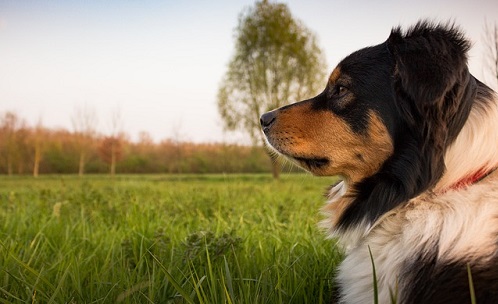Rabies is an aggressive, acute and devastating viral disease that can affect any warm-blooded mammal, although bats, skunks, foxes, raccoons, cats, and dogs are often the most susceptible to becoming a carrier. It’s a disease that has been around for thousands of years, with the earliest known writings that describe it dating as early as 23 B.C. Thankfully, in more modern times like today, the disease is not nearly as prevalent, largely due to vaccinations as well as elimination programs and vigorous regulations and quarantines across the globe.
However, rabies does still exist, and it’s particularly prevalent in countries that aren’t as developed as the West. Sadly, once clinical signs of rabies begin to appear, whether the victim is a dog or a human or some other animal, the virus is considered fatal and has no known cure.
What is Rabies in Dogs?
Rabies stems from the encephalomyelitis virus, which attacks a dog’s central nervous system and the grey matter of the brain. It is transmitted through saliva, typically from a bite like you might receive from a wild animal. However, a bite isn’t necessary to become infected. Saliva can find its way into an open wound or orifice on the body and still infect its target. There have even been some very rare instances where infection occurred through inhalation of bat saliva after entering a cave full of bats.
However, it is rare for a domestic dog to contract rabies unless they are exposed to a wild animal and bitten, such as a raccoon or even a feral cat. Rabies in cats is on the rise, which increases the risk to domestic dogs as well as humans. Rabies in dogs has an incubation period ranging from two weeks to four months in length. How quickly your dog may develop clinical signs of rabies depends on bite severity, how much of the virus was passed along through the bite, and where your dog was bitten.
The nearer a bite is to the brain or spinal cord, the faster clinical signs may develop. Again, once a dog has begun to display clinical signs of rabies, death is almost certain. Because the virus moves so quickly, if treatment isn’t started right away, the prognosis for recovery is extremely poor. If you suspect your dog has been bitten by a rabid animal, you should take them to a vet immediately to be quarantined and begin vaccination or booster shots and treatment, even if your dog has been vaccinated before. Be careful to wear protective clothing and gear, and don’t risk exposing yourself to the virus.
Clinical Signs of Rabies in Dogs
If left untreated, as rabies progress, your dog will undergo three different phases. After the 3rd phase, roughly 3-7 days after the onset of initial clinical signs, death will occur.
Rabies in Dogs: Prodromal Phase
 This is the initial phase of rabies in dogs that lasts anywhere from 2-3 days. During this phase, you may notice behavior changes in your dog. They may suffer from a fever, you may notice their eye reflexes seem slow, and they may chew or lick at the spot they were bitten. Dogs that are normally laid back may flip and become very aggressive, dangerous, and unpredictable. They may bite or snap at anything. Dogs with aggression may flip and become needy, attention-seeking, and seem more affectionate than usual. You may also notice restlessness, nervousness and anxiety in dogs with rabies
This is the initial phase of rabies in dogs that lasts anywhere from 2-3 days. During this phase, you may notice behavior changes in your dog. They may suffer from a fever, you may notice their eye reflexes seem slow, and they may chew or lick at the spot they were bitten. Dogs that are normally laid back may flip and become very aggressive, dangerous, and unpredictable. They may bite or snap at anything. Dogs with aggression may flip and become needy, attention-seeking, and seem more affectionate than usual. You may also notice restlessness, nervousness and anxiety in dogs with rabies
Rabies in Dogs: Furious Phase
The next phase of rabies in dogs lasts anywhere from 2-4 days. During this phase, a dog may experience hypersensitivity, they may eat things that are not food (pica), they may hide somewhere dark and soothing, attack inanimate objects (even the sides of their cage if they are locked up), they may bark and if they aren’t caged, they may roam. They can also appear to be disoriented and even suffer from canine seizures.
Rabies in Dogs: Paralytic Phase
This phase lasts anywhere from 2-4 days as well, and it is the stage that you may begin to notice drooling and foaming at the mouth that is often depicted in movies, as well as signs of dog paralysis, especially in the face and throat. These symptoms may cause changes in their bark and cause their jaw to drop.
Paralysis usually begins in the limb a dog was bitten, but it progresses quickly. During this phase a dog will also experience canine depression, possibly begin to cough, and eventually move into a coma. From there, the result is death from respiratory failure due to paralysis.
List of Progressive Warning Signs of Rabies in Dogs
First Phase
- Irritability
- Restlessness
- Fever
- Shyness
- Snapping and biting
- Docile behavior out of the norm
- Unusually aggressive behavior
- Licking, chewing, and biting at the site of the bite
Final Two Phases
- Increased sensitivity
- Difficulty swallowing
- Heavy breathing
- Jaw hanging open
- No control over the throat
- Staggering, lack of coordination
- Paralysis of the hind legs
- Pica (eating things that aren’t food)
- Hiding (usually in a dark place)
- Disorientation
- Foaming at the mouth
- Weakness
- Trembling
- Appetite loss
- Fear of water
- Pupils may be dilated
- Seizures
Diagnosing Rabies in Dogs
Unfortunately, there is not currently any way to accurately diagnose a case of rabies in a living animal. There is a procedure called the direct fluorescent antibody test, and is considered to be the most accurate, but it requires a sample of brain tissue.
This means it’s a test that can only be performed after the dog has died. In most cases, if you suspect your dog may have been infected, you need to call your vet right away. If your dog is already displaying clinical signs such as aggression or trying to attack you, don’t try to catch and cage them yourself. Call animal control and enlist their help.
Once your dog is caught, they will be quarantined for at least 10 days under your vet’s supervision, in an effort to confirm a rabies diagnosis. If your dog has been vaccinated in the past, you will need to show proof to your vet. While in quarantine, if the dog dies your vet may collect fluid samples. Blood testing can sometimes be done to detect the presence of the rabies virus, but it’s not a procedure performed by vets.
If your dog begins to show clinical and progressive symptoms of the rabies virus while quarantined, in most cases he will be put down. If your dog was unvaccinated and bit by an animal known to have the rabies virus, he must be quarantined according to state and local regulations. This quarantine can last up to 6 months.
Treatment and Prevention of Rabies in Dogs
The best way to treat your dog is to prevent your dog from contracting rabies in the first place. Vaccinations are vital and in the U.S. rabies vaccinations are mandatory, though not all dogs in the U.S. have been vaccinated as they are supposed to be.
If you suspect your dog has been exposed to the rabies virus and he has been vaccinated, it’s required that he is re-vaccinated and then quarantined. If the dog has never been vaccinated, the dog must be euthanized, or quarantined for 6 months and then vaccinated if the owner is unwilling to put them down. This is the best way to prevent the spread of rabies, as harsh as it may seem.
Check with local and state regulations for the proper vaccine schedule, but in most cases, it’s recommended that dogs receive their first vaccine at least by the age of 4-6 months old.
 A second vaccination is recommended after one year of age, and then inoculations may be recommended every three years throughout your dog’s lifespan. It’s estimated that a dog could potentially receive 6-10 rabies shots throughout their life, depending on how long they live.
A second vaccination is recommended after one year of age, and then inoculations may be recommended every three years throughout your dog’s lifespan. It’s estimated that a dog could potentially receive 6-10 rabies shots throughout their life, depending on how long they live.
Though the statistics are small, some dogs do have a poor reaction to the vaccine, but the fact is, the vaccines work and have significantly reduced the instances of rabies in domesticated animals and humans.
There are some charitable organizations studying rabies and the vaccines given to dogs, in the hopes of standardizing a treatment schedule. It’s possible extending the span of time between rabies vaccines from 3 years to 5 years could help reduce the number of vaccines a dog must receive in its life, without reducing the vaccine’s effectiveness in preventing and controlling the spread of the disease.
Adverse Reaction Warning Signs of the Rabies Vaccine
If you have vaccinated your dog and notice any signs or symptoms that don’t seem normal, you should contact your vet right away.
Atypical reactions include:
- Vomiting
- Fever
- Pain, swelling, redness around the injection site
- Hair loss and scabbing around the injection site
- Sluggish behavior
- Appetite loss
- Hives
- Swollen face
- Diarrhea
- Difficulty breathing
- Lameness
- Collapse
- Seizures
If your dog can’t tolerate the vaccines, you can talk with your vet about your options. Sometimes a waiver of the rabies vaccine can be given. If your dog struggles with tolerating the vaccines, you could try spacing them out more to give him plenty of time to recover. Make sure you wait before vaccinating if you think your dog may be feeling unwell. You will also want to make sure you schedule vaccines during times that you can be present and closely supervise your dog.
Risks of Rabies in Dogs
Dogs that are allowed to roam around outside unsupervised are at a higher risk of getting bit by an infected animal because their exposure to wildlife increases and they are more likely to run into strays that may be infected with the rabies virus. To reduce that risk, you’re highly encouraged to walk your dog on a leash or supervise them closely when you are outside.
Rabies is considered zoonotic, which means that the virus can spread from dog to dog, as well as from dog to another animal, and from dog to human. This is why there are such strict rules and regulations around the rabies virus, around mandatory vaccines, and around international travel of pets. There are even some locations that require strict quarantines because they have been declared rabies-free and want to maintain that status.
If you suspect there is a rabid animal in your area, take steps to keep your home and your dog safe. Make sure any holes in your home are caulked and sealed, make sure your patio screens are intact with no holes or rips, cover things like attic vents with screening and if you have a chimney, install caps.
You should also make sure all your doors are shut properly when you enter and exit your home, and only allow your dog outside on a leash. You can also contact animal control to let them know if you suspect there is an animal in the area with rabies, and they can be on the lookout to capture and quarantine it.
Though rabies is much less common today than in the past, there are still risks of your dog contracting the virus, especially if they are exposed to wildlife or a stray that is known to be infected. Make sure they are vaccinated, receive any necessary booster shots, and do what you can to keep them out of harm’s way.




